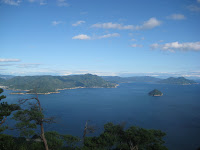(View from top of Mt Misen on the island of Miyajima, on the outskirts of Hiroshima)

Clear summer sky, peaceful blue waters dotted with islands. In a flash, it all changed - for Hiroshima and the world. 'Hiroshima' was burned into our collective memories even as we grew up in far off India."Hiroshoma-Nagasaki" we said in one breath with some idea of its history but absolutely no idea of the geography of it (the two cities are several kms apart, on different islands). And now here I was standing in one of the cities.
What did I expect? Bombed out buildings, ash flying , sad faced people? I searched ghoulishly for clues of the disaster. I could see none. Obviously. Hiroshima seemed like any other present day Japanese city. Tall buildings, cars, trams (different from Tokyo or Kyoto), wide roads and of course ubiquitously 'Starbucked'! Hiroshima seemed to have mended and mended well (Sixty two whole years later? What am I thinking?).
Hiro-shima (meaning 'wide island') is set on the beautiful delta of the Otagawa river. It is built on a series of sandy islands criss crossed by rivers.It was cold bloodedly chosen years ago from a shortlist of Japanese cities (so we are told in the Peace Memorial Museum) for its inocuousness. It had neither the grandeur nor the importance of a Tokyo or Kyoto.Its very innocence sounded its death knell. And also the clear weather on Aug 6 1945 - bad weather would have meant an aborted sortie.

Memorials have a way of wrenching your gut out. The moment you step in you feel the gravity of the past weighing down on you. I am convinced the ghosts never really leave.Every stone/relic has seen the horrors. It was the same strong feeling that assailed me when I visited the Tuol Sleng concentration camp ("S-21") in Phnom Penh two years ago- one of the sites of the unspeakable horror unleashed on innocent people by Pol Pot and his 'Khmer Rouge' regime in Cambodia. Utterly gut wrenching.

The 'A-Bomb' Dome (now a memorial then a Government Office - picture on right, top)) still stands untouched, in its bombed state on the edge of the Honkawa River. 'Gembaku-Domu'. A skeleton of a building with burnt walls and scattered bricks. It stands roughly below the point , where 'Enola Gay' dropped "Little Boy" 62 years ago. In a matter of seconds, an area of two kms around the hypocenter was razed to ashes. People caught in its eye suffered death, grievous injury and/or long term effects from radiation. All these stories are poignantly described in the Peace Memorial Museum across the A-Dome, on the other side of the river.The Hall of Rembarance is another sombre structure with the names of the victims and recorded testimonies of survivors and relatives of victims.
The two places can take a whole day to absorb fully. The sadness is in the ordinary details. Peeled off clothes of victims along with their exact whereabouts at the moment, their watches stopped at 8.15 - the exact time of the bombing, a torn satchel, a charred lunch box, a finger nail, clumps of hair.
Its hard not to be moved.


A walk through the museum leaves you rapt. You just wonder what the roughly 300,000 innocent people, caught by surprise that morning, did to deserve this. A cold analysis of history might tell us that Japan had to be brought to heel at the time. Taught a lesson. But surely the school boy carrying his lunch box of rice and red beans had nothing to pay for? Did the end justify the means?


We are told that the bomb unleashed in seconds an unimaginable magnitude of heat, sound and radiation energy that left people two kms away with melted hands and burnt faces. After a while, black rain poured over Hiroshima - a result of the extreme heat generated by the bomb. People didnt understand what it was. Some drank the water hoping it would give them relief. Many survivors died of cancer months or years later. Some had glass or shrapnel extracted twenty years later. It was the mental wounds that probably never healed for the hibakusha (A- bomb survivor) and Japan.
It was a daunting thought as we walked the area - the memorial, our hotel,the cafe - that the very place, now normal and full of life, sixty two years ago was a burning hell, flattened out by a big ball of fire packed with hostility and aimed to kill. Nothing would grow in Hiroshima for a hundred years more, went the belief. But it did.And it gave us hope.
In the time it took the city and its people to rebuild , have we learnt our lessons I wondered?
The answer, it dawns on me, is neither simple nor comfortable...




5 comments:
did that work?? i seem to be missing a couple of posts here?
the dragonfly pic particularly poignant. Sadly, historical memory does not go beyond a generation for most ppl. We hardly hear/observe the carnage in Hiroshima/Nagasaki these days. And precisely why posts such as this makes one sit up and think...
... keep 'em coming!
Vidya - u talking abt a post I briefly posted before this and then cancelled? Thought best to post it after this...or is there some other problem in viewing?
btw am busy getting 'all comfortable' in Sing now...
Harish - Good feeling that the post 'reached out' to you. Agree with u on that - with fading generations, so will memories and Hiroshima will become just another cold historical fact.Suspect it almost has even in Japan...?
hi preethy,
even pico iyer cant describe Japan so vividly! your blog brings out the contradictions in this modern yet ancient society so beautifully.
As promised here is the link to my blog, hope you enjoy reading it as much as I did yours
Vivid and moving. Sniff.
Post a Comment